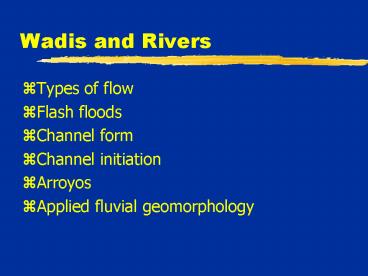Wadis and Rivers - PowerPoint PPT Presentation
1 / 26
Title: Wadis and Rivers
1
Wadis and Rivers
- Types of flow
- Flash floods
- Channel form
- Channel initiation
- Arroyos
- Applied fluvial geomorphology
2
Types of Flow
- Ephemeral
- flow with a short duration
- several events each year
- Perennial
- a stream that flows continuously throughout the
year
3
Perennial Dryland Rivers
- Exoreic sources is sustained in drylands
- Character is similar to humid rivers
- Key difference is high specific yields
4
Ephemeral Flash Floods
- Irregular and short duration
- High intensity rainfall
- Unsteady, non uniform flow
- High sediment loads
- High transmission losses
- Difficult to measure
5
- For a given rainfall intensity, rains
- in drylands produce more runoff per
- unit area than in temperate environments.
6
Characteristics
- Short time to peak
- Sharp peak (10-30 mins in)
- Short duration (1-5 hours)
- Less steep recession limb
- bore
7
(No Transcript)
8
Bores
- Caused by
- intense storm
- rapid translation of water
- interaction of wave and transmission losses
- velocity increases d/s
- bore grows d/s
9
Channel Routing
- Important because
- Storm cells have limited spatial extent
- A single storm is unlikely to affect the whole
catchment - Successive storms wet different areas of the
catchment - Cells migrate as they deliver the rain
10
A
B
C
11
Transmission Loss
- Volume of channel discharge that infiltrates into
channel bed - Due to coarse grained alluvial deposits
- Economic significance of loss
- loss of irrigation water
- problems for flood prediction and design
- effects ground water recharge
12
- Magnitude of transmission loss related to
- flow duration
- channel length and width
- antecedent moisture conditions
- peak discharge
- properties of alluvium
- patterns of flood waves
- sediment load
13
Sediment Loads
- High suspended sediment load (SSC)
- High amounts of scour
- Rapid deposition
14
Channel Form
- Very variable
- Wide with flat bedforms
- Poorly adjusted to imposed discharge
- Long profiles constant or convex
- Poor network integration
- High drainage density
- arid gt semiarid gt humid
15
Channel Processes
- Scour
- Transport
- Deposition
- Seepage from GW
- Bank failure
- Vegetative growth
- weathering
- Chemical ppt
- Particulate movement
16
Scour (Entrainment)
- highly variable
- vertical and lateral
- related to competence of flow
- complicated by armouring
- inhibited in early stages of floods by cemented
clay layer
17
Transport
- depends on available energy
- related to frictional losses
- vegetation depends on
- time of year of flood
- stem spouting ability
- number of seeds
- roughness increase with flow
18
Deposition
- aggradation net deposition
- results from loss of power
- produces fans
- depositional features
- control transmission losses
- determine scour for low flows
- provide clues to sequence of flows
19
Piping
- Subterranean channels
- Important form of subsurface water and sediment
discharge - Increases with
- soluble salt content
- content of swelling clays
- surface runoff
- hydraulic gradient
20
Channel Initiation
- Stability theory
- Carson and Kirkby 1972
- Smith and Bretherton 1972
- Erosion thresholds
- Horton 1945
21
Stability Theory
- mathematical analysis of process laws
- examines conditions under which a small
perturbation will grow or shrink - unstable growth occurs if convergence of flow
allows more sediment to be removed than is
brought in - occurs if sediment transport increases more than
linearly with water discharge
22
Erosion Thresholds
- Tractive stress versus material resistance
- Hortons belt of no erosion
23
Kirkby (1994)
- Combined the two approaches
- Progressive change in response from stability
conditions to threshold behaviour - Semi-arid - humid environments
24
Arroyos
- Trench with steep sides and rectangular cross
section - Created by rapid incision into valley floor
alluvium - Widespread in SW USA
- Main period of arroyo cutting 1865-1915
25
Arroyo Hypothesis
- Cutting is a result of force vs resitance
- Flow velocity ?
- ? discharge
- ? channel slope
- ? Flow depth
- Resistance ?
- ? surface roughness
- ? vegetation
26
Applied Fluvial Geomorphology in Drylands
- Irrigation
- Soil and water conservation
- Reservoir sedimentation
- Flash flood hazard
- Water quality
- Water politics































